Survey on Household Solid Waste Sorting at Source in Developing Economies: A Case Study of Nur-Sultan City in Kazakhstan
Abstract
1. Introduction
2. Materials and Methods
2.1. Description of the Study Area
2.2. Design of Survey and Survey Participants
| SS | sample size; |
| z | confidence level (typically z-score equal to 1.96 for 95% confidence level); |
| e | acceptable level of sampling error (margin of error typically 0.05% ± 5%); |
| N | population size (p = 1,035,537); and |
| P | population proportion (50%; i.e., 0.5 by default). |
3. Results and Discussion
3.1. Survey Analysis by Gender, Marital Status, and Age
3.2. Social Activity Level of Residents
3.3. Sorters versus Nonsorters
3.4. The Overall Feedback and Motivation/Demotivation Factors
4. Conclusions
Author Contributions
Funding
Acknowledgments
Conflicts of Interest
References
- Skryhan, H.; Shilova, I.; Khandogina, O.; Abashyna, K.; Chernikova, O. Waste management in post-soviet countries: How far from the EU? Detritus 2018, 3, 193–203. [Google Scholar] [CrossRef]
- MEP KZ, National Report “On the State of the Environment and Use of Natural Resources in 2011–2014” p. 70. Available online: http://ecogosfond.kz/wp-content/uploads/2018/03/NDSOS_2011-2014.pdf (accessed on 18 August 2019).
- MEP KZ, National Report 2017 “On the State of the Environment and Use of Natural Resources” section 9 “waste”, p. 153. Available online: ecogosfond.kz/wp-content/uploads/2019/02/nac_doklad_ru.zip (accessed on 18 August 2019).
- Inglezakis, V.J.; Moustakas, K.; Khamitova, G.; Tokmurzin, D.; Sarbassov, Y.; Rakhmatulina, R.; Serik, B.; Abikak, Y.; Poulopoulos, S.G. Current municipal solid waste management in the cities of Astana and Almaty of Kazakhstan and evaluation of alternative management scenarios. Clean Technol. Environ. Policy 2018, 20, 503–516. [Google Scholar] [CrossRef]
- Inglezakis, V.J.; Rojas-Solorzano, L.; Kim, J.; Aitbekova, A.; Ismailova, A. Comparison between landfill gas and waste incineration for power generation in Astana, Kazakhstan. Waste Manag. Res. 2015, 33, 486–494. [Google Scholar] [CrossRef]
- Assamoi, B.; Lawryshyn, Y. The environmental comparison of landfilling vs. incineration of MSW accounting for waste diversion. Waste Manag. 2012, 32, 1019–1030. [Google Scholar] [CrossRef]
- Intergovernmental Panel on Climate Change (IPCC). 2006. Available online: https://www.ipcc-nggip.iges.or.jp/public/2006gl/pdf/0_Overview/V0_1_Overview.pdf (accessed on 2 March 2019).
- Intergovernmental Panel on Climate Change (IPCC). 2006. Available online: https://www.ipcc-nggip.iges.or.jp/public/2006gl/pdf/2_Volume2/V2_2_Ch2_Stationary_Combustion.pdf (accessed on 2 March 2019).
- Inglezakis, V.J.; Amzebek, A.; Kuspangaliyeva, B.; Sarbassov, Y.; Balbayeva, G.; Yerkinova, A.; Poulopoulos, S.G. Treatment of municipal solid waste landfill leachate by use of combined biological, physical and photochemical processes. Desalination Water Treat. 2018, 112, 218–231. [Google Scholar] [CrossRef]
- RGRK. Resolution of the Government of the Republic of Kazakhstan dated by June 9, 2014 No. 634 “On the Approval of the Program for the Modernization of the Municipal Solid Waste Management System for 2014–2050.”. Available online: https://greenkaz.org/images/for_news/pdf/npa/programma-modernizacii-tbo.pdf (accessed on 14 February 2019).
- KazNIIEK. Guidelines for the Calculation of Greenhouse Gas Emissions in the Atmosphere from Municipal Solid Waste Landfills. 2010. Available online: https://www.egfntd.kz/upload/NTD/MERK/12.pdf (accessed on 2 November 2018).
- United Nations Development Programme (UNDP). 2012. Available online: https://www.thegef.org/sites/default/files/project_documents/7-31-2013_ID4442__Project_doc_2.pdf (accessed on 2 July 2019).
- Urcha, S. Municipal Solid Waste Prospects in Astana city. In Proceedings of the Workshop Presentations:” Green Energy and Municipal Solid Waste”, Nazarbayev University, Kazakhstan, 12 September 2018; Available online: https://nur.nu.edu.kz/handle/123456789/3529 (accessed on 15 January 2019).
- Mieszkis, K.W.; Thomas, F.E. Source separation of post-consumer waste. Conserv. Recycl. 1979, 3, 413–425. [Google Scholar] [CrossRef]
- Chen, H.; Yang, Y.; Jiang, W.; Song, M.; Wang, Y.; Xiang, T. Source separation of municipal solid waste: The effects of different separation methods and citizen’s inclination-case study of Changsha, China. J. Air Waste Manag. Assoc. 2017, 67, 182–195. [Google Scholar] [CrossRef]
- Rousta, K.; Dahlen, L. Source separation of household waste: Technology and social aspects. In Resource Recovery to Approach Zero Municipal Waste; Taherzadeh, M.J., Richards, T., Eds.; CRC Press: Boca Raton, FL, USA, 2017; pp. 61–76, Chapter 4. [Google Scholar] [CrossRef]
- Almazán-Casali, S.; Alfaro, J.F.; Sikra, S. Exploring household willingness to participate in solid waste collection services in Liberia. Habitat Int. 2019, 84, 57–64. [Google Scholar] [CrossRef]
- Cheng, C.Y.; Urpelainen, J. Who should take the garbage out? Public opinion on waste management in Dar es Salaam, Tanzania. Habitat Int. 2015, 46, 111–118. [Google Scholar] [CrossRef]
- Guerin, D.; Crete, J.; Mercier, J. A multilevel analysis of the determinants of recycling behavior in the European countries. Soc. Sci. Res. 2001, 30, 195–218. [Google Scholar] [CrossRef]
- Martin, M.; Williams, I.D.; Clark, M. Social, cultural and structural influences on household waste recycling: A case study. Resour. Conserv. Recycl. 2006, 48, 357–395. [Google Scholar] [CrossRef]
- Jesson, J. Household waste recycling behavior: A market segmentation model. Soc. Mark. Q. 2009, 15, 25–38. [Google Scholar] [CrossRef]
- Meneses, G.D.; Palacio, A.B. Recycling behavior a multidimensional approach. Environ. Behav. 2005, 37, 837–860. [Google Scholar] [CrossRef]
- Taylor, S.; Todd, P. Understanding household garbage reduction behavior: A test of an integrated model. J. Public Policy Mark. 1995, 14, 192–204. [Google Scholar] [CrossRef]
- Vining, J.; Ebreo, A. What makes a recycler?: A comparison of recyclers and nonrecyclers. Environ. Behav. 1990, 22, 55–73. [Google Scholar] [CrossRef]
- Thøgersen, J. A model of recycling behaviour, with evidence from Danish source separation programmes. Int. J. Res. Mark. 1994, 11, 145–163. [Google Scholar] [CrossRef]
- Nixon, H.; Saphores, J.D.M. Information and the decision to recycle: Results from a survey of US households. J. Environ. Plann. Manag. 2009, 52, 257–277. [Google Scholar] [CrossRef]
- Ezeah, C.; Roberts, C.L. Analysis of barriers and success factors affecting the adoption of sustainable management of municipal solid waste in Nigeria. J. Environ. Manag. 2012, 103, 9–14. [Google Scholar] [CrossRef]
- Tucker, P.; Smith, D. Simulating household waste management behaviour. J. Artif. Soc. Soc. Simul. 1999, 2, 1–3. [Google Scholar]
- Tucker, P. Understanding recycling behaviour. Paper Technol. 2001, 42, 51–54. [Google Scholar]
- Tonglet, M.; Phillips, P.S.; Read, A.D. Using the Theory of Planned Behaviour to investigate the determinants of recycling behaviour: A case study from Brixworth, UK. Resour. Conserv. Recycl. 2004, 41, 191–214. [Google Scholar] [CrossRef]
- Fan, B.; Yang, W.; Shen, X. A comparison study of ‘motivation-intention-behavior’ model on household solid waste sorting in China and Singapore. J. Clean. Prod. 2019, 211, 442–454. [Google Scholar] [CrossRef]
- Meng, X.; Tan, X.; Wang, Y.; Wen, Z.; Tao, Y.; Qian, Y. Investigation on decision-making mechanism of residents’ household solid waste classification and recycling behaviors. Resour. Conserv. Recycl. 2019, 140, 224–234. [Google Scholar] [CrossRef]
- Orazbayev, Z.Z.; Yermekov, T.Y.; Dolgov, M.V. Research and Feasibility of Parameters of Consumption and Production Wastes Utilization. Ministry of Education and Science of the Republic of Kazakhstan, L.N. Gumilyov Eurasian National University: Kazakhstan, 2013. Available online: http://www.enu.kz/downloads/nauka/othody-eng.doc/ (accessed on 5 November 2018).
- Stat.gov.kz. Available online: http://stat.gov.kz (accessed on 20 August 2019).
- Kerimray, A.; Bakdolotov, A.; Sarbassov, Y.; Inglezakis, V.J.; Poulopoulos, S. Air pollution in Astana: Analysis of recent trends and air quality monitoring system. Mater. Today Proc. 2018, 5, 22749–22758. [Google Scholar] [CrossRef]
- Abylkhani, B.; Aiymbetov, B.; Yagofarova, A.; Tokmurzin, D.; Venetis, C.; Poulopoulos, S.; Sarbassov, Y.; Inglezakis, V.J. Seasonal characterization of municipal solid waste from Astana city, Kazakhstan; composition and thermal properties of combustible fraction. Waste Manag. Res. 2019. (accepted for publication). [Google Scholar] [CrossRef]
- Informburo.kz. Official News on Launching 6200 Containers for Separate HSW Collection at Source. Available online: https://informburo.kz/novosti/ustanovku-6200-konteynerov-dlya-sbora-razdelnogo-musora-nachali-v-astane.html (accessed on 12 October 2018).
- Dillman, D.A. Mail and Internet Surveys: The Tailored Design Method–2007 Update with New Internet, Visual, and Mixed-mode Guide; John Wiley & Sons: Hoboken, NJ, USA, 2011. [Google Scholar]
- Wang, X.; Zhang, Y.; Huang, Z.; Hong, M.; Chen, X.; Wang, S.; Feng, Q.; Meng, X. Assessing willingness to accept compensation for polluted farmlands: A contingent valuation method case study in northwest China. Environ. Earth Sci. 2016, 75, 179. [Google Scholar] [CrossRef]
- Sample Size Calculators. Available online: https://www.smartsurvey.co.uk/sample-size-calculator (accessed on 1 May 2019).
- Yoo, S.H.; Kwak, S.Y. Willingness to pay for green electricity in Korea: A contingent valuation study. Energy Policy 2009, 37, 5408–5416. [Google Scholar] [CrossRef]
- Ekere, W.; Mugisha, J.; Drake, L. Factors influencing waste separation and utilization among households in the Lake Victoria crescent, Uganda. Waste Manag. 2009, 29, 3047–3051. [Google Scholar] [CrossRef]
- Babaei, A.A.; Alavi, N.; Goudarzi, G.; Teymouri, P.; Ahmadi, K.; Rafiee, M. Household recycling knowledge, attitudes and practices towards solid waste management. Resour. Conserv. Recycl. 2015, 102, 94–100. [Google Scholar] [CrossRef]
- Padilla, A.J.; Trujillo, J.C. Waste disposal and households’ heterogeneity. Identifying factors shaping attitudes towards source-separated recycling in Bogotá, Colombia. Waste Manag. 2018, 74, 16–33. [Google Scholar] [CrossRef]
- Rousta, K.; Bolton, K.; Lundin, M.; Dahlen, L. Quantitative assessment of distance to collection point and improved sorting information on source separation of household waste. Waste Manag. 2015, 40, 22–30. [Google Scholar] [CrossRef]
- Challcharoenwattana, A.; Pharino, C. Wishing to finance a recycling program? Willingness-to-pay study for enhancing municipal solid waste recycling in urban settlements in Thailand. Habitat Int. 2016, 51, 23–30. [Google Scholar] [CrossRef]
- Chu, Z.; Xi, B.; Song, Y.; Crampton, E. Taking out the trash: Household preferences over municipal solid waste collection in Harbin, China. Habitat Int. 2013, 40, 194–200. [Google Scholar] [CrossRef]
- Kelly, T.C.; Mason, I.G.; Leiss, M.W.; Ganesh, S. University community responses to on-campus resource recycling. Resour. Conserv. Recycl. 2006, 47, 42–55. [Google Scholar] [CrossRef]
- Vassanadumrongdee, S.; Kittipongvises, S. Factors influencing source separation intention and willingness to pay for improving waste management in Bangkok, Thailand. Sustain. Environ. Res. 2018, 28, 90–99. [Google Scholar] [CrossRef]
- Lakhan, C. Out of sight, out of mind: Issues and obstacles to recycling in Ontario’s multi residential buildings. Resour. Conserv. Recycl. 2016, 108, 1–9. [Google Scholar] [CrossRef]
- Rispo, A.; Williams, I.D.; Shaw, P.J. Source segregation and food waste prevention activities in high-density households in a deprived urban area. Waste Manag. 2015, 44, 15–27. [Google Scholar] [CrossRef] [PubMed]
- Sekitoa, T.; Prayogo, T.B.; Dote, Y.; Yoshitake, T.; Bagus, I. Influence of a community-based waste management system on people’s behavior and waste reduction. Resour. Conserv. Recycl. 2013, 72, 84–90. [Google Scholar] [CrossRef]
- Xu, L.; Ling, M.; Lu, Y.; Shen, M. External influences on forming residents’ waste separation behaviour: Evidence from households in Hangzhou, China. Habitat Int. 2017, 63, 21–33. [Google Scholar] [CrossRef]
- CGEGD, Green Kaz News: Astana has Started Launching Special Containers. (2016). Available online: https://greenkaz.org/index.php/press-centr/novosti-v-strane/item/939-zdes-zhivet-plastik-v-astane-nachali-ustanovku-spetsialnykh-kontejnerov/ (accessed on 5 May 2019).
- Frey, B.S. Not Just for the Money. An Economic Theory of Personal Motivation; Edward Elgar Publishing: Cheltenham, UK, 1997. [Google Scholar]
- Stern, P.C. Understanding individuals’ environmentally significant behavior. Environ. Law Rep. News Anal. 2005, 35, 10785–10790. [Google Scholar]
- Zhang, B.; Lai, K.H.; Wang, B.; Wang, Z. From intention to action: How do personal attitudes, facilities accessibility and government stimulus matter for household waste sorting? J. Environ. Manag. 2019, 233, 447–458. [Google Scholar] [CrossRef] [PubMed]
- Austin, J.; Hatfield, D.B.; Grindle, A.C.; Hatfield, D. Increasing recycle in office environments: The effects of specific, informative cues. J. Appl. Behav. Anal. 1993, 26, 247–253. [Google Scholar] [CrossRef] [PubMed]
- O’Connor, R.T.; Lerman, D.C.; Fritz, J.N.; Hodde, H.B. Effects of number and location of bins on plastic recycling at a university. J. Appl. Behav. Anal. 2010, 43, 711–715. [Google Scholar] [CrossRef] [PubMed]
- Boldero, J. The prediction of household recycling of newspapers: The role of attitudes, intentions and situational factors. J. Appl. Soc. Psychol. 1995, 25, 440–462. [Google Scholar] [CrossRef]
- Barr, S. Factors influencing environmental attitudes and behaviors: A U.K. case study of household waste management. Environ. Behav. 2007, 39, 435–473. [Google Scholar] [CrossRef]
- Krahè, B. Personality and Social Psychology: Towards a synthesis; Sage Publications Ltd.: London, UK, 1992; Available online: https://publishup.uni-potsdam.de/opus4-ubp/frontdoor/deliver/index/docId/3655/file/Krahe_Personality_and_Social_Psychology.pdf/ (accessed on 28 February 2019).
- Lehman, P.K.; Geller, E.S. Behavior analysis and environmental protection: Accomplishments and potential for more. Behav. Soc. Issues 2005, 13, 13–32. [Google Scholar] [CrossRef]
- Song, Q.; Wang, Z.; Li, J. Residents’ attitudes and willingness to pay for solid waste management in Macau. Procedia Environ. Sci. 2016, 31, 635–643. [Google Scholar] [CrossRef]
- Hanyu, K.; Kishino, H.; Yamashita, H.; Hayashi, C. Linkage between recycling and consumption: A case of toilet paper in Japan. Resour. Conserv. Recycl. 2000, 30, 177–199. [Google Scholar] [CrossRef]
- Welfens, M.J.; Nordmann, J.; Seibt, A. Drivers and barriers to return and recycling of mobile phones. Case studies of communication and collection campaigns. J. Clean. Prod. 2016, 132, 108–121. [Google Scholar] [CrossRef]
- Chakrabarti, S.; Majumder, A.; Chakrabarti, S. Public-community participation in household waste management in India: An operational approach. Habitat Int. 2009, 33, 125–130. [Google Scholar] [CrossRef]
- Yukalang, N.; Clarke, B.; Ross, K. Barriers to effective municipal solid waste management in a rapidly urbanizing area in Thailand. Int. J. Environ. Res. Public Health 2017, 14, 1013. [Google Scholar] [CrossRef] [PubMed]
- Tiew, K.G.; Basri, N.E.A.; Deng, H.; Watanabe, K.; Zain, S.M.; Wang, S. Comparative study on recycling behaviours between regular recyclers and non regular recyclers in Malaysia. J. Environ. Manag. 2019, 237, 255–263. [Google Scholar] [CrossRef]
- Gonzalez-Torre, P.L.; Adenso-Díaz, B. Influence of distance on the motivation and frequency of household recycling. Waste Manag. 2005, 25, 15–23. [Google Scholar] [CrossRef] [PubMed]
- Refsgaard, K.; Magnussen, K. Household behaviour and attitudes with respect to recycling food waste-experiences from focus groups. J. Environ. Manag. 2009, 90, 760–771. [Google Scholar] [CrossRef] [PubMed]
- Bernstad, A. Household food waste separation behavior and the importance of convenience. Waste Manag. 2017, 34, 1317–1323. [Google Scholar] [CrossRef] [PubMed]
- Warunasinghe, W.A.A.I.; Yapa, P.I. A survey on household solid waste management (SWM) with special reference to a peri-urban area (Kottawa) in Colombo. Procedia Food Sci. 2016, 6, 257–260. [Google Scholar] [CrossRef][Green Version]
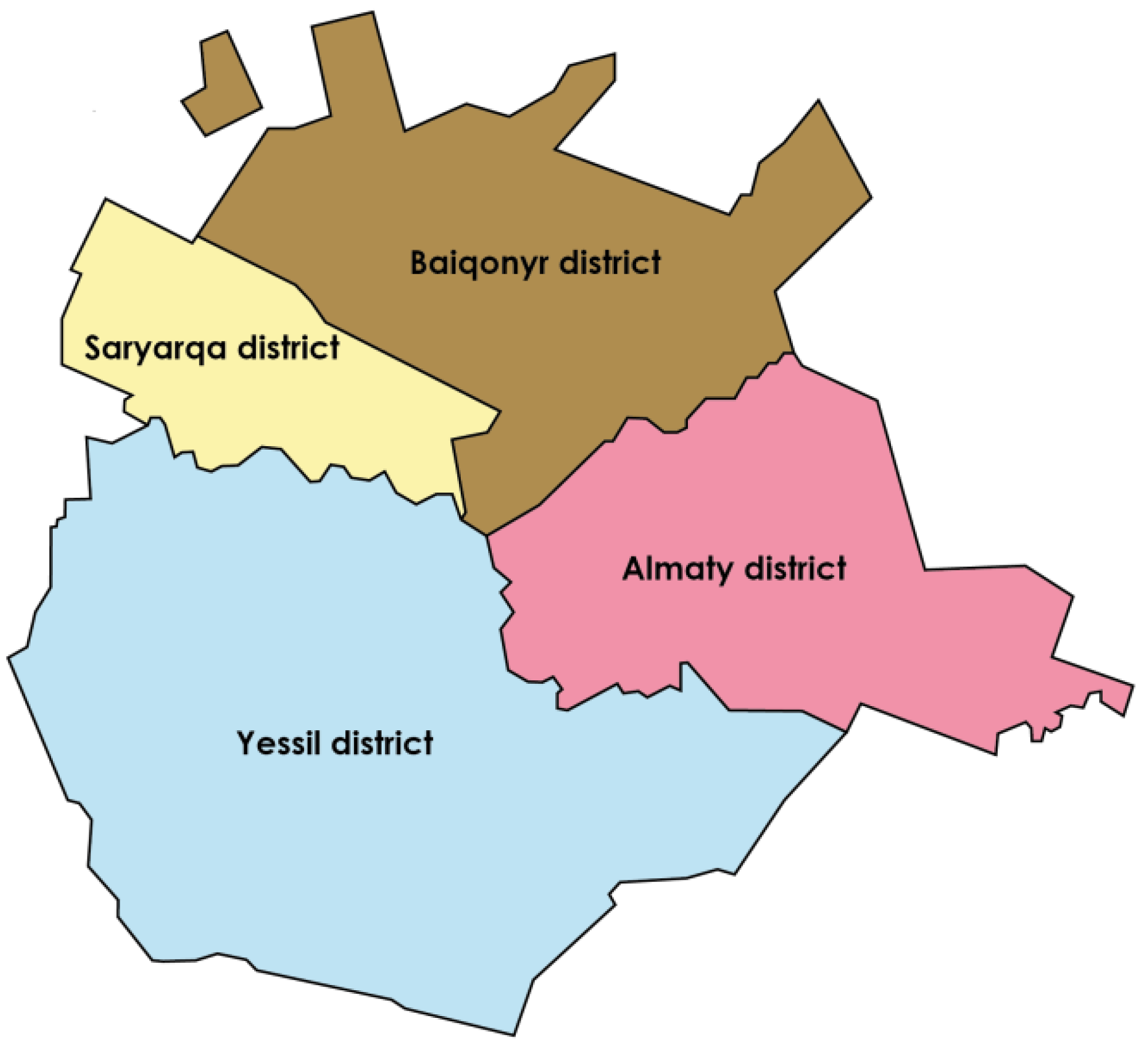
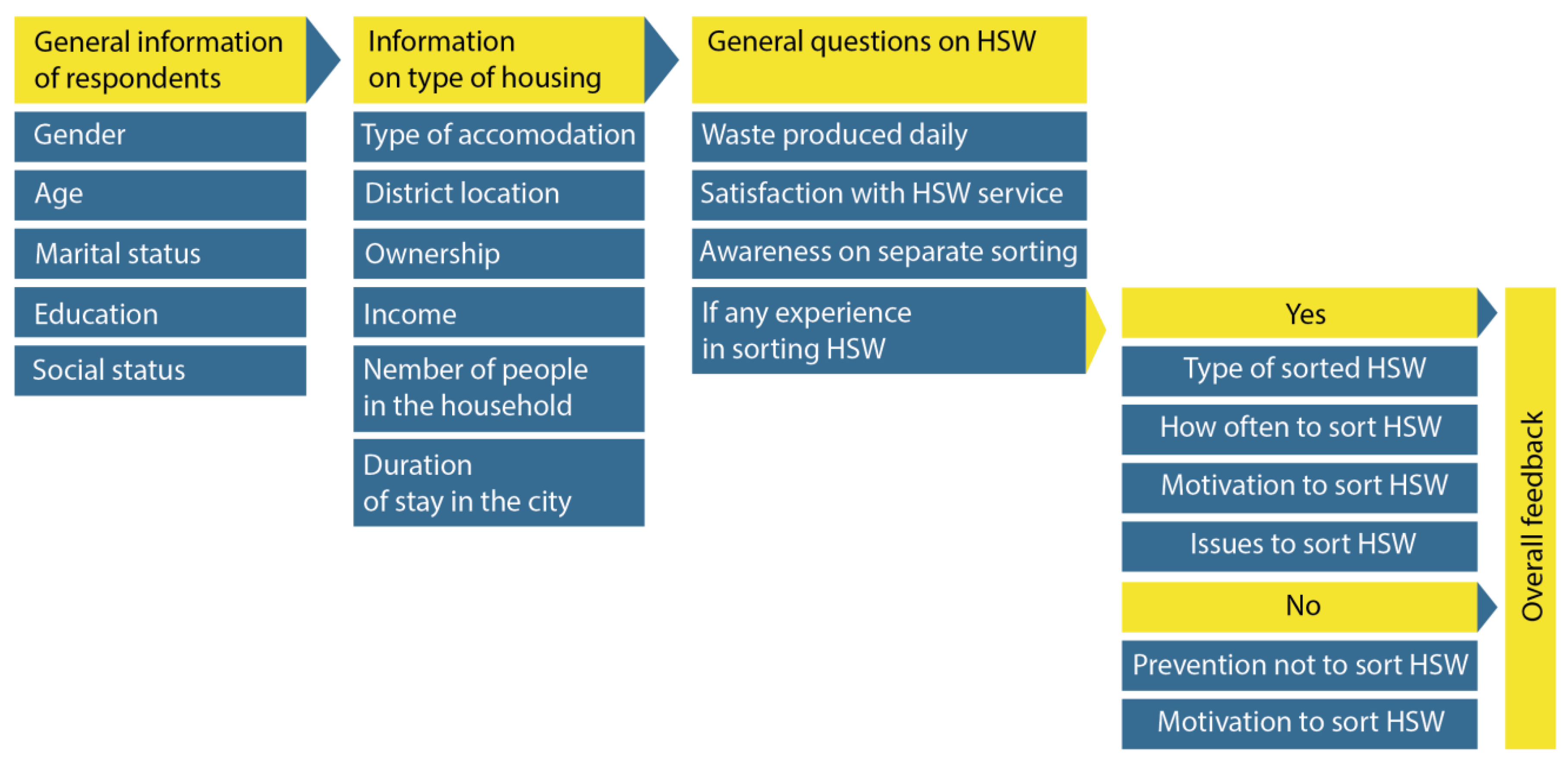
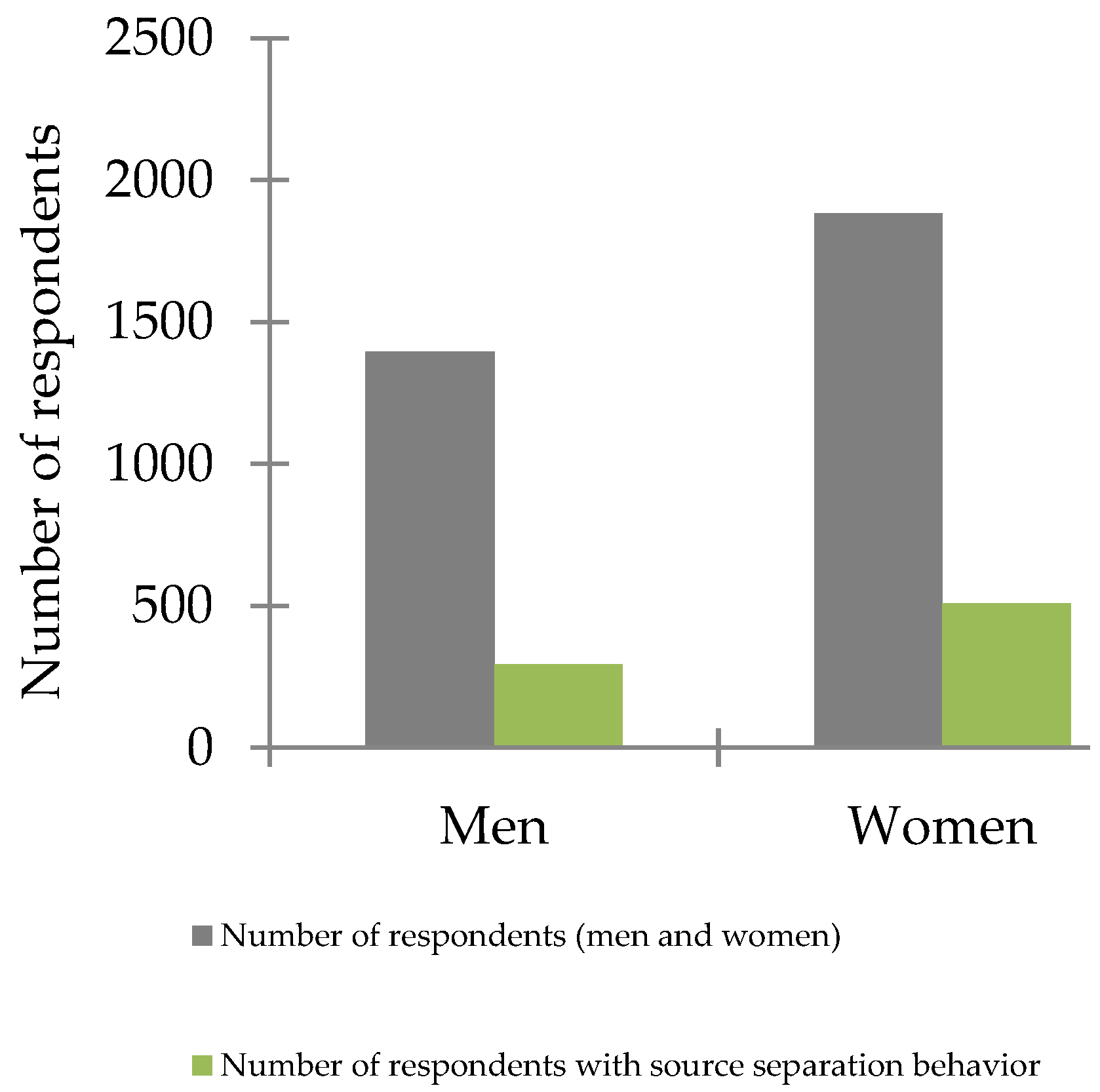
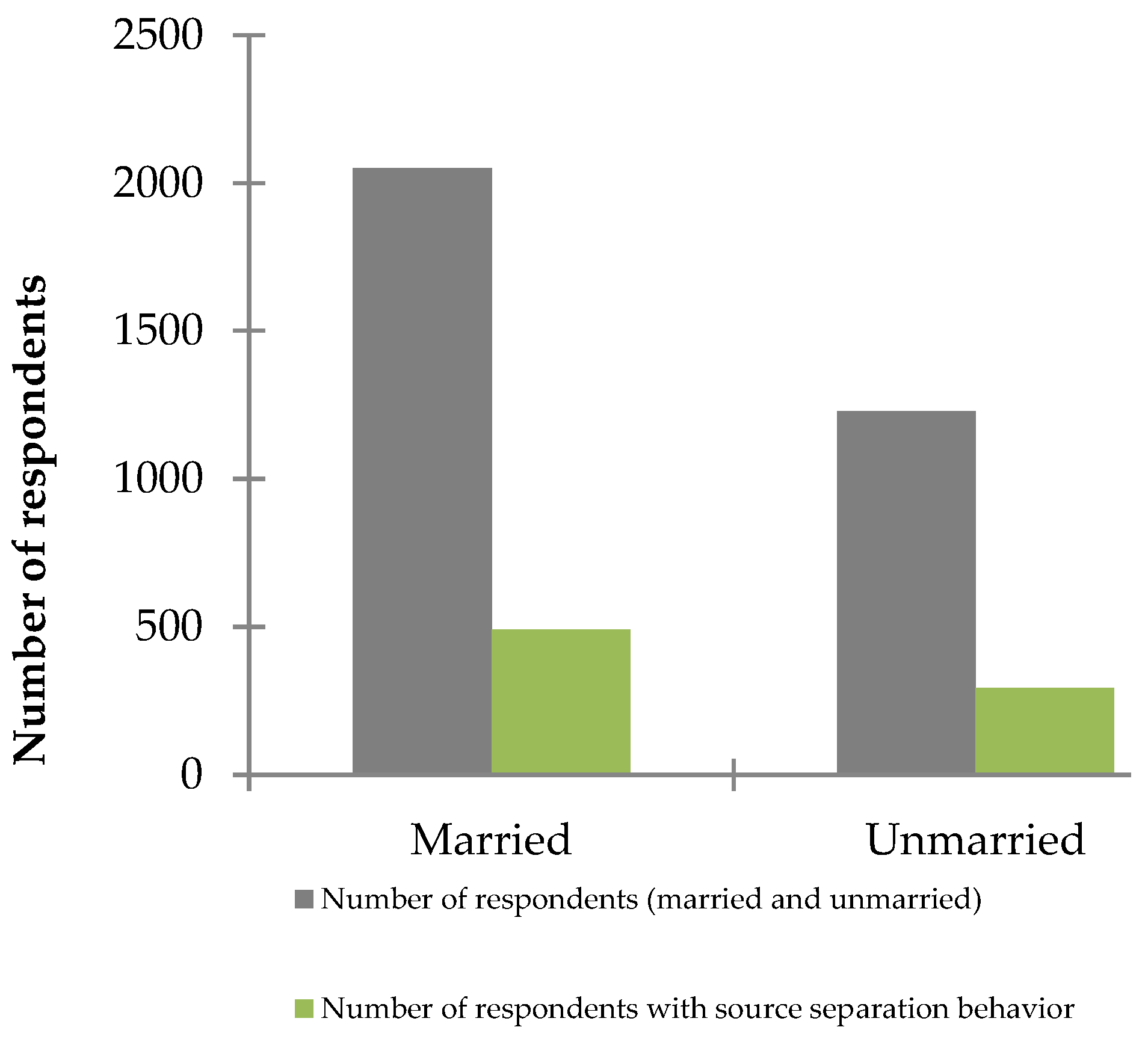
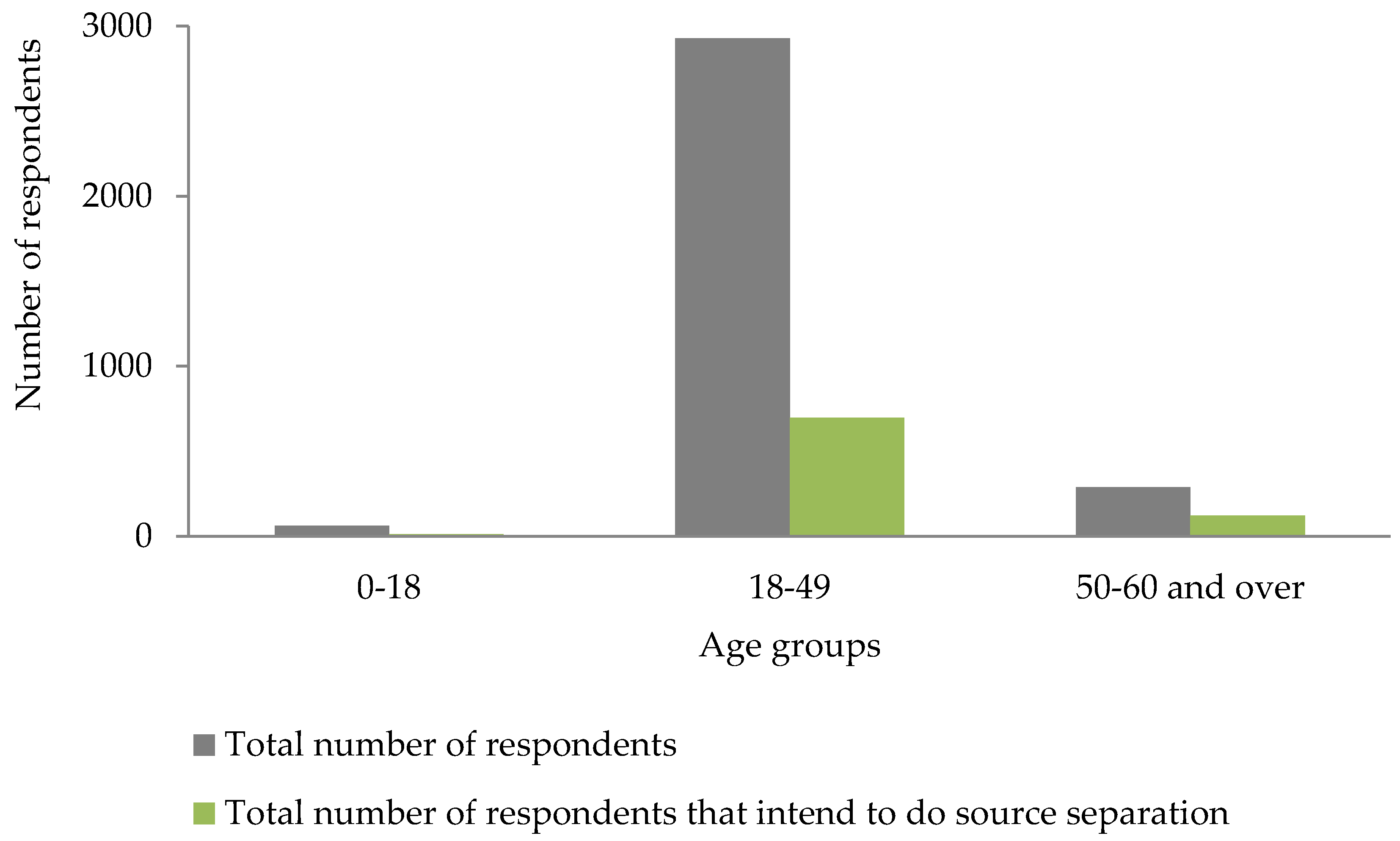
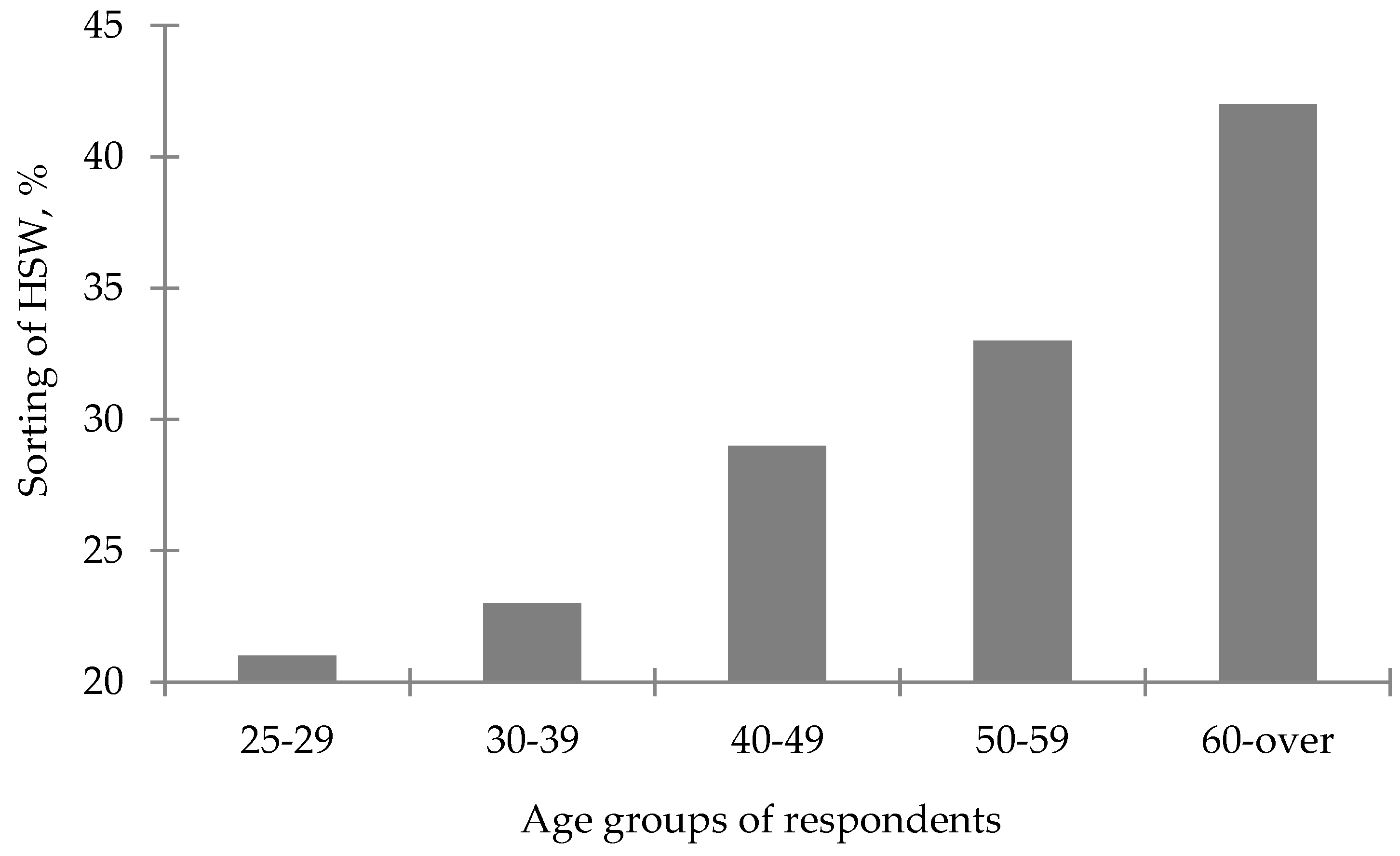
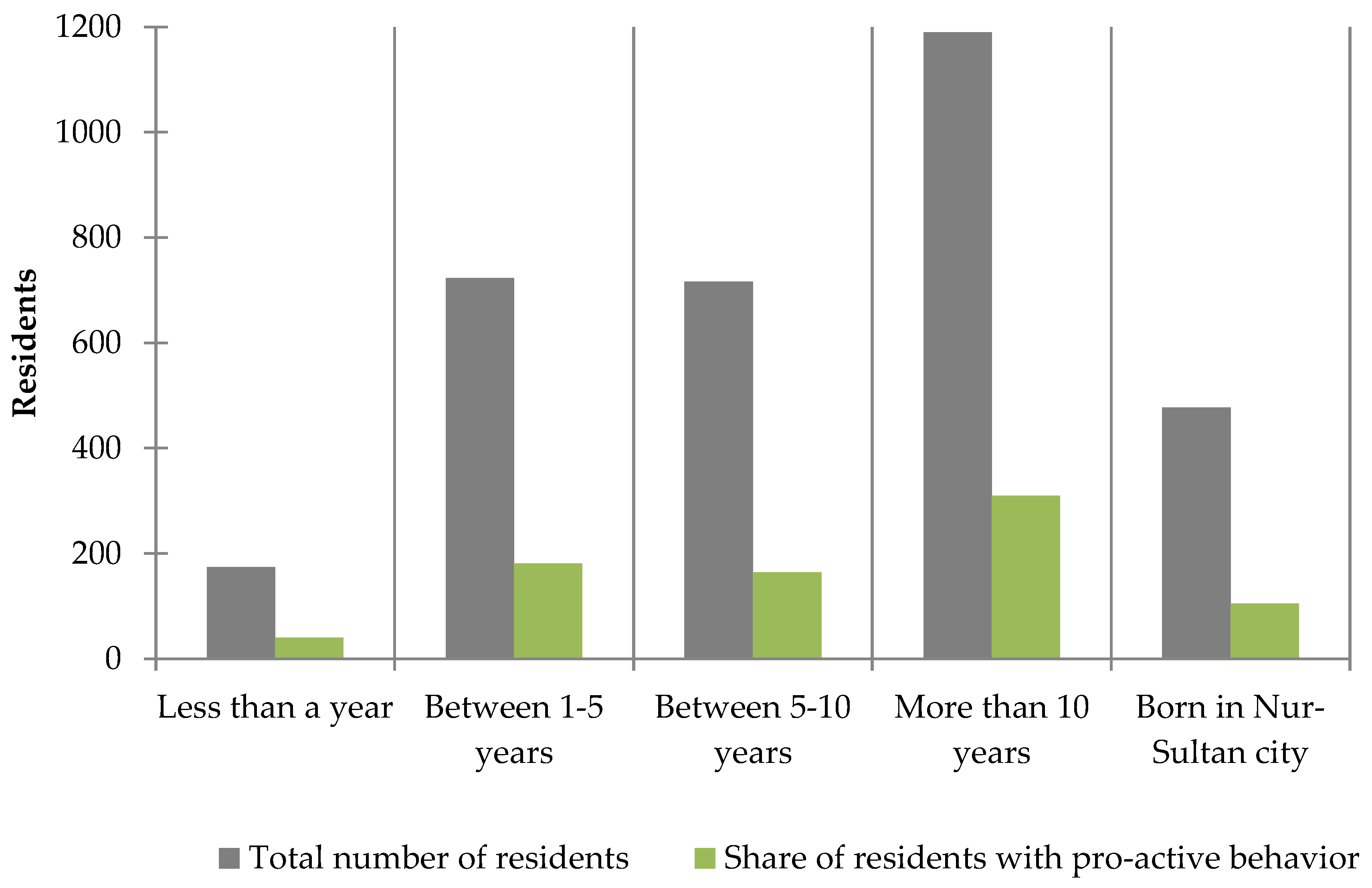

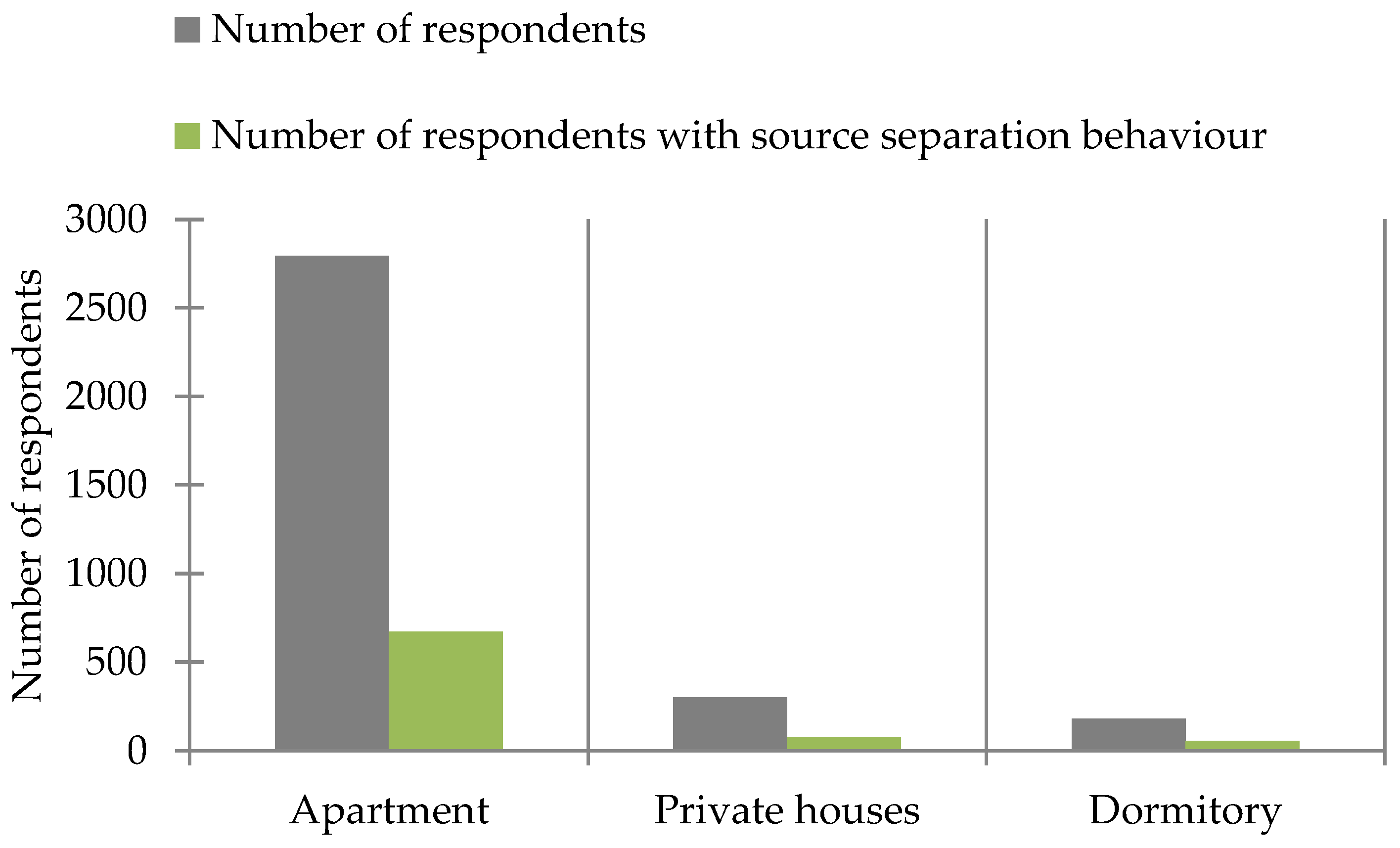
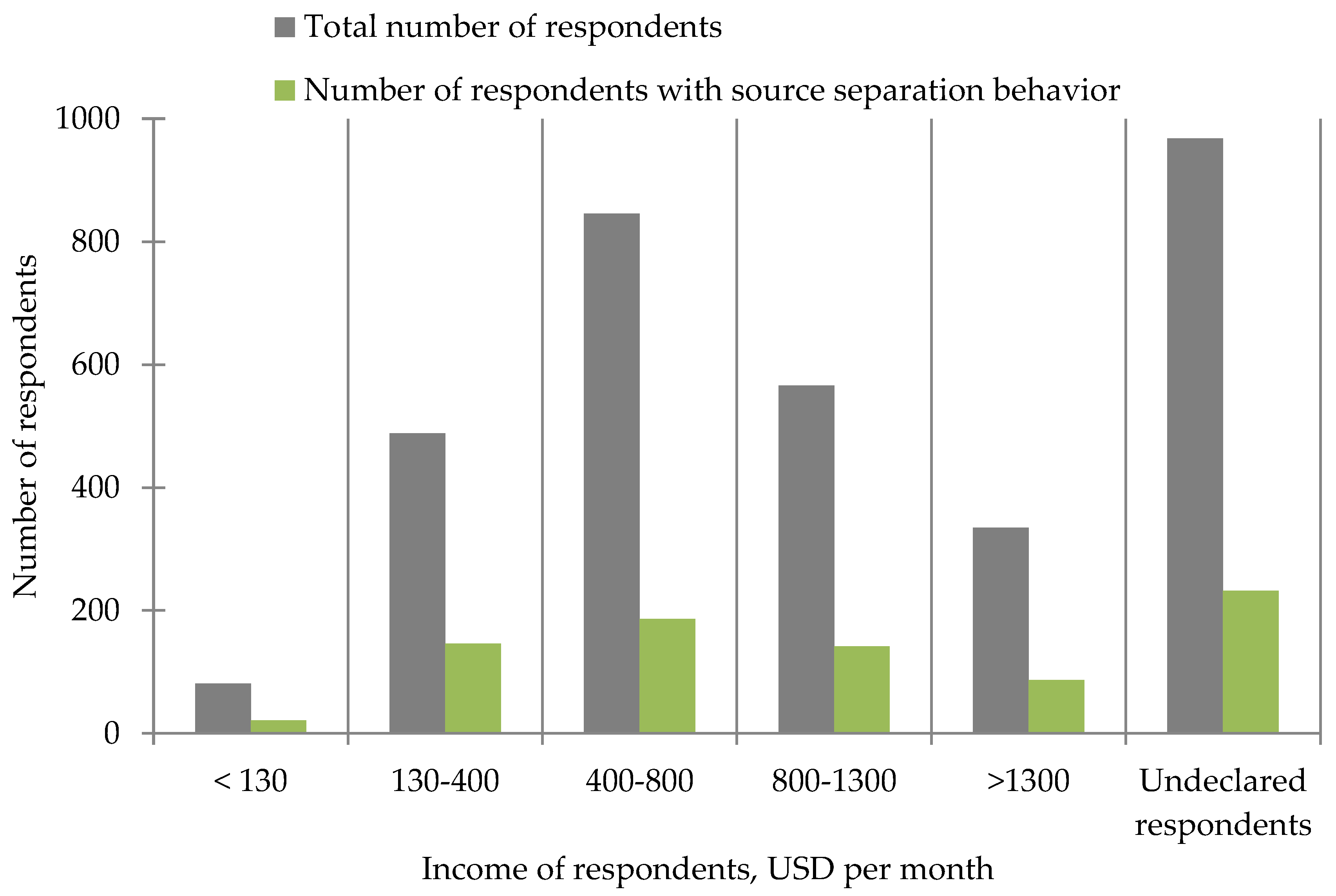
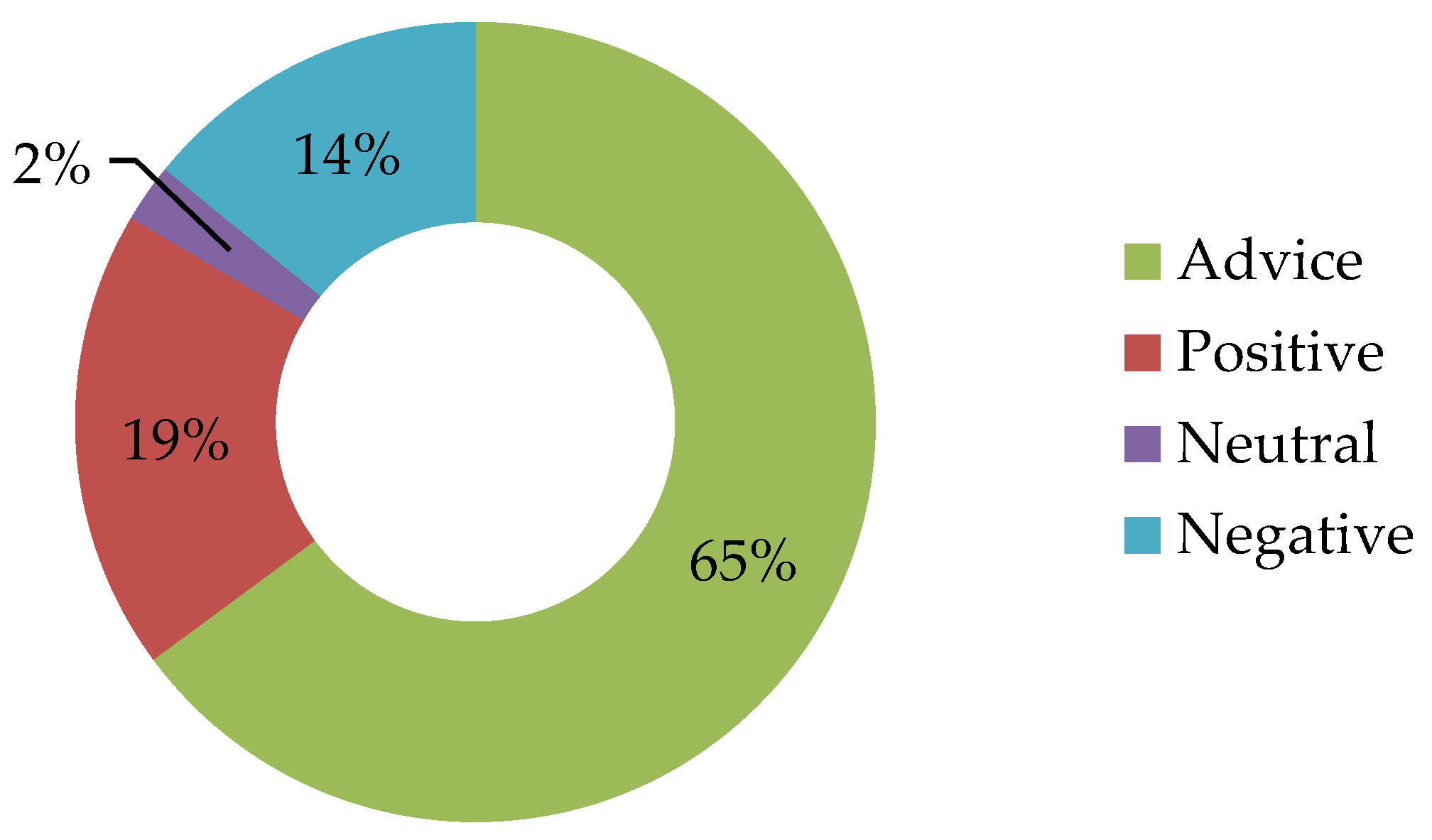
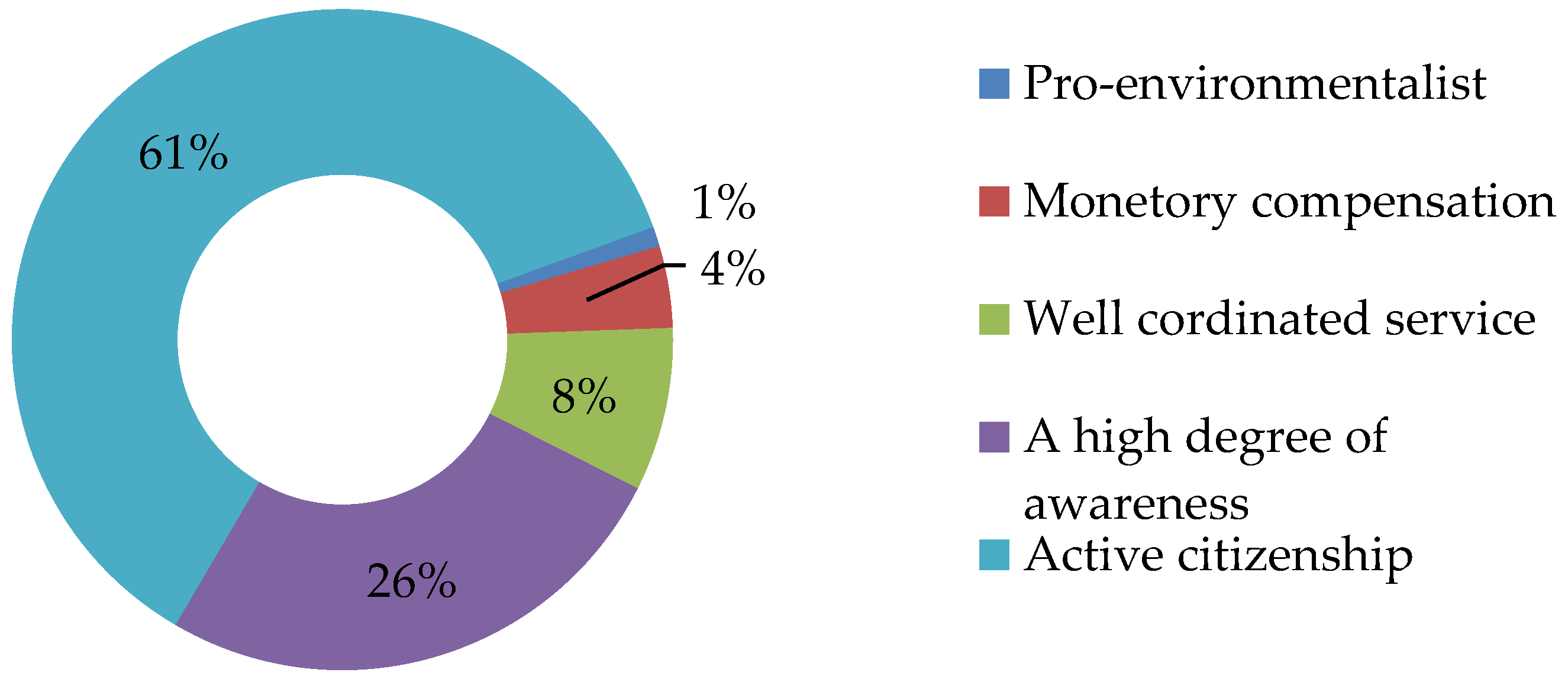
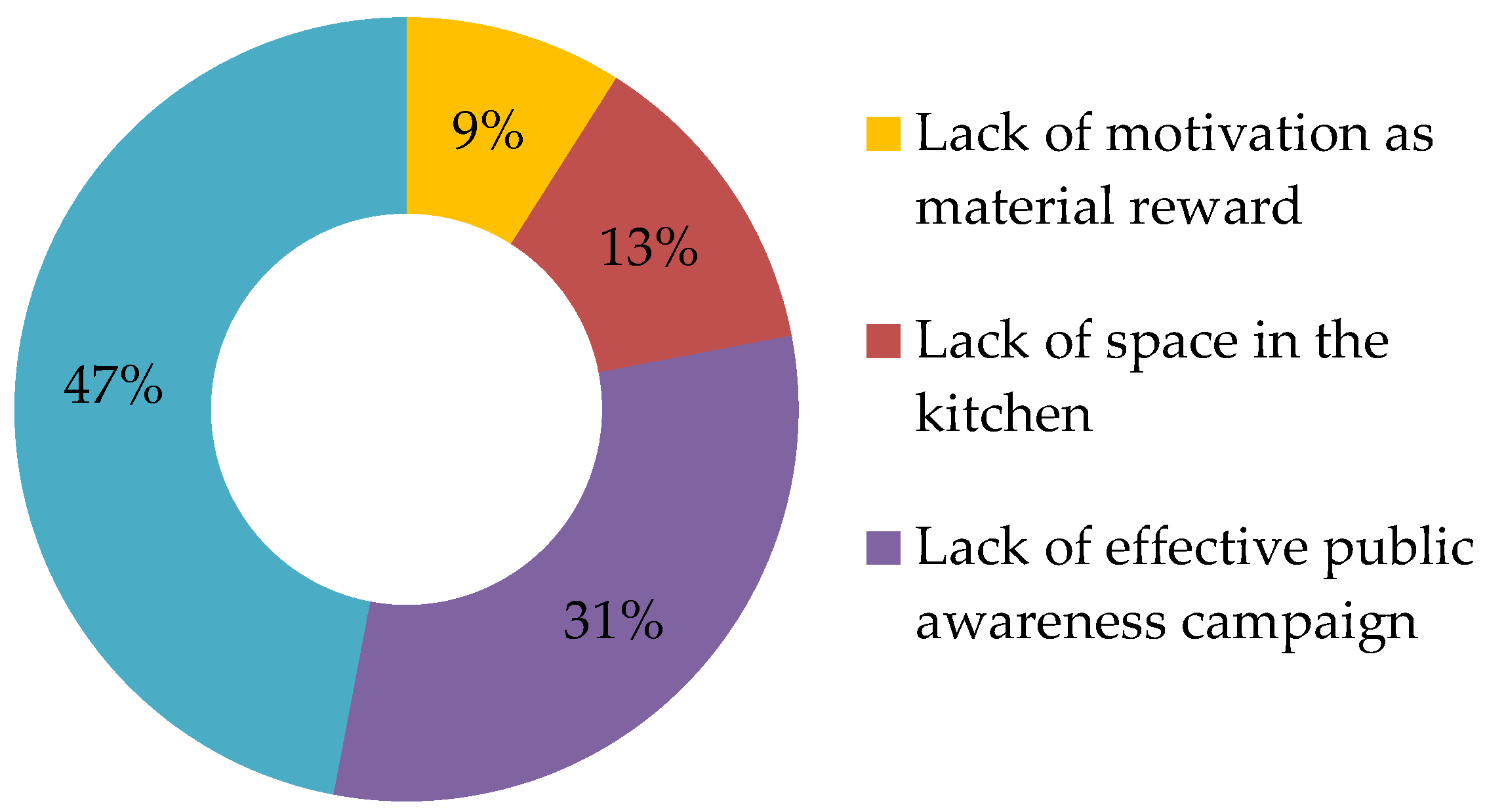
| Data from 01 January of 2016 | Data from January of 2019 | |||||
|---|---|---|---|---|---|---|
| Age distribution | Total | Male | Female | Total | Male | Female |
| 0–15 years old | 242,820 | 124,790 | 118,030 | 326,021 | 167,370 | 158,651 |
| 16–62 years old | 567,491 | 278,805 | 288,686 | 671,977 | 327,121 | 344,856 |
| 58–62 and higher | 62,273 | 17,100 | 45,173 | 80,386 | 23,131 | 57,255 |
| Population | 872,584 | 420,695 | 451,889 | 1078,384 | 517,22 | 560,762 |
| Fractions | Annual, % (Standard Deviation) |
|---|---|
| Organics | 47.2 (±1.6) |
| Plastic | 15.4 (±1.4) |
| Paper | 12.5 (±1.1) |
| Glass | 6.2 (±1.2) |
| Diapers | 6.2 (±0.4) |
| Fine (<12 mm) | 3.5 (±0.8) |
| Textile & Leather | 3.4 (±0.6) |
| Fe Metals | 2.0 (±0.3) |
| C&D | 0.9 (±0.4) |
| Miscellaneous | 0.8 (±0.1) |
| Wood | 0.8 (±0.4) |
| Non-Fe Metals | 0.7 (±0.2) |
| WEEE | 0.6 (±0.2) |
| C&D—construction and demolition waste, WEEE—electrical and electronic equipment waste | |
| Channels used During the Survey | Responds | % |
|---|---|---|
| Electronic-KSK (Apartment Owner’s Association) application (online) | 1021 | 31 |
| Active city groups on Facebook (online) | 443 | 14 |
| Staff of Nazarbayev University (online)4 | 102 | 3.1 |
| Students of Nazarbayev University (online) 4 | 239 | 7.3 |
| Residents of residential complex “Vienna quarter” (online) | 80 | 2.4 |
| Residents of “BI group” flats (online) | 427 | 13.0 |
| Paper-based survey of city residents (printed and distributed on the back side of bills) | 898 | 27.4 |
| Face-to-face interview (filled in printed questionnaire) | 70 | 2.1 |
| Total | 3281 | 100 |
© 2019 by the authors. Licensee MDPI, Basel, Switzerland. This article is an open access article distributed under the terms and conditions of the Creative Commons Attribution (CC BY) license (http://creativecommons.org/licenses/by/4.0/).
Share and Cite
Sarbassov, Y.; Sagalova, T.; Tursunov, O.; Venetis, C.; Xenarios, S.; Inglezakis, V. Survey on Household Solid Waste Sorting at Source in Developing Economies: A Case Study of Nur-Sultan City in Kazakhstan. Sustainability 2019, 11, 6496. https://doi.org/10.3390/su11226496
Sarbassov Y, Sagalova T, Tursunov O, Venetis C, Xenarios S, Inglezakis V. Survey on Household Solid Waste Sorting at Source in Developing Economies: A Case Study of Nur-Sultan City in Kazakhstan. Sustainability. 2019; 11(22):6496. https://doi.org/10.3390/su11226496
Chicago/Turabian StyleSarbassov, Yerbol, Tolkyn Sagalova, Obid Tursunov, Christos Venetis, Stefanos Xenarios, and Vassilis Inglezakis. 2019. "Survey on Household Solid Waste Sorting at Source in Developing Economies: A Case Study of Nur-Sultan City in Kazakhstan" Sustainability 11, no. 22: 6496. https://doi.org/10.3390/su11226496
APA StyleSarbassov, Y., Sagalova, T., Tursunov, O., Venetis, C., Xenarios, S., & Inglezakis, V. (2019). Survey on Household Solid Waste Sorting at Source in Developing Economies: A Case Study of Nur-Sultan City in Kazakhstan. Sustainability, 11(22), 6496. https://doi.org/10.3390/su11226496






